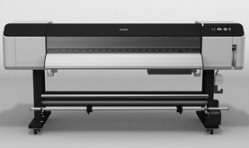Wide-format inkjet printers have changed and improved considerably since they first became commercially viable in the mid-1990s. Thermal (or bubble jet) systems were the original inkjet printer class in the wide-format marketplace, but new categories of printer have been introduced over the years with varying degrees of success.
 For the beverage wholesaler print shop, the question is: What technology is out there now that can make my output more efficient, cost effective and visually appealing? In this analysis, we’re going to look at some of the major benefits and drawbacks of current inkjet categories for operators in this highly specialized business.
For the beverage wholesaler print shop, the question is: What technology is out there now that can make my output more efficient, cost effective and visually appealing? In this analysis, we’re going to look at some of the major benefits and drawbacks of current inkjet categories for operators in this highly specialized business.
Ask the right questions
In analyzing multiple inkjet printing technologies, the question is not which is superior, but which is best for your particular production scenario. That requires looking some additional factors beyond the obvious. For example:
- Are there hidden costs or additional factors that will increase labor expenses?
- What is the actual payback on lower cost consumables if the initial hardware is significantly more expensive?
- Are there health and safety issues?
- Am I paying for more printer than I need?
- How much space does the printer occupy?
Because inkjet printheads are ink formula specific, printers are classified by the type of ink they use:
- aqueous (bubble jet)
- solvent system
- UV curable
- latex water-based.
Since aqueous systems account for the greatest number of units in beverage wholesaler marketing operations, it makes sense to use that technology as a baseline. Therefore we’ll be referencing the Canon iPF8000S and HP Designjet Z6100, the two models that currently dominate beverage market graphics.
Let’s look at some of the other inkjet printing currently being offered in this market:
Latex “Green” Printers
The new kid on the block is the latex water-based technology first introduced by HP in the form of the Designjet L25500. According to the promotional material, the new printers offer the media versatility associated with solvent printers, but without the environmental issues. The inks contain no hazardous materials and many of the consumables are eligible for HP’s recycling programs.
Latex inks can produce durable prints with scratch-, smudge- and water-resistance that is said to be comparable to eco- and low-solvent ink results. For this technology, print media doesn’t require a coating to encapsulate and protect the inks.
Although this printer is still very new to the marketplace, some less obvious features are worth noting:
- the machine requires two separate 220V power supplies that will require additional electrical work prior to installation.
- the printer runs extremely hot, because it employs internal heaters to dry and cure the latex polymers (some reports are that it can be uncomfortable standing five feet away). More importantly, there is a performance issue related to the heat. For the many print shops that rely on inexpensive polypropylene media, printing with the L25500 is not an option because the heat will distort the material. Whatever advantages are associated with the latex inks, it is clear that changeover will require re-thinking print media usage.
The Designjet L25500 42-in. model sells for $20,000+ and the 60-in. model lists for about $25,000.
Solvent/Eco-solvent
Ink formulations for printers in this category vary quite a bit their content of volatile organic compounds (VOCs). Thus, a multitude of terms are used to classify these printers, e.g., solvent (or hard solvent), eco-solvent, mild solvent or light solvent. Naturally, printer performance differs – sometimes significantly – from one ink solvent category to another and from one brand to another. This is especially true with regard to print media compatibility.

In theory, the primary advantage of solvent inks over water-based inks is that they can print on a wider range of substrates, including uncoated media. By all means, this can result in lower consumable costs over time. Depending on the printer brand, solvent systems open the door to printing on outdoor materials without requiring lamination. This provides a cost advantage if you expect to print a lot of extended-use outdoor graphics.
On the other hand, owners of solvent system printers are unlikely to print on 13 oz. heavy vinyl banner materials for indoor promotional graphics. For these applications, the most common solutions are solvent-compatible poster paper or solvent-compatible polypropylene, which are generally priced equal to or higher than supplies for aqueous inkjets.
It should also be noted that media compatibility varies quite a bit between lighter solvent and “hard” solvents. Some eco-solvent inks require top-coated media because they don’t have the “bite” of true solvents, and are not noted for their compatibility with polypropylene material. Any type of solvent-system printer will require a careful look at the media available, including third-party offerings. And if you are locked into manufacturer-branded consumables, expect higher prices.
With regard to work safety and environmental issues, the belief that eco-solvent printers require no ventilation falls into a gray area that might require additional investigation on your part. Legal requirements and oversight vary according to state and actual health hazards vary according to ink type. Eco-solvent printers such as the Epson Stylus Pro GS6000 or the Roland SOLJET III XJ series may be exempt from venting requirements in some states, but a hard solvent machine such as the Mutoh Osprey will require professional venting. States such as California require permitting and extensive venting systems which can result in additional thousands of dollars in cost.
Balancing the potential lower consumables costs of solvent/eco-solvent printers is the much higher price tags for solvent system printers. Popular eco-solvent printers such as the Epson GS6000 and Roland SOLJET III XJ Series begin at about $26,000 and go up from there, depending on the printing width. The cheaper MutohOsprey sells for under $20,000, but it is a hard solvent printer with all the benefits and drawbacks associated with that technology.
Extended warranties can add several thousand dollars per year to the total for any machine in this category, as they are more maintenance-intensive than aqueous-ink printers.
Considering that some models in the latest generation of wide-format aqueous printers can be purchased for under $5,000, the math is not all that complicated when computing your potential consumables savings with solvent printers. At your existing or anticipated print volume, how long will it take to recoup the difference in cost between aqueous inkjet materials and solvent system inkjet materials? If you are printing a lot of outdoor banners, your payback could come quickly. If you print mostly indoor POS, the ROI might never come.
While we’re on the subject of consumables costs, remember that it’s also important to include the ink mileage factor for each printer model you are looking at. Remember that manufacturers continue to improve aqueous technology as well. The Canon iPF8000S, for example, now uses approximately 30% less ink than other aqueous inkjet models. That fact can change the math on consumables cost significantly.
Print quality also remains a factor in aqueous vs. solvent printing comparisons, as bubble jet technology is still unequaled for brightness and color gamut. Whether this is a key factor in your decision naturally depends on the competitive situation in your local market.
Print speed, on the other hand, is always a factor in a business that requires turning jobs around on a dime on a day-to-day basis. You can expect solvent printers to operate at about half the speed of aqueous models. In addition, solvent inks require longer drying time for virtually any non-vinyl media.
Finally, note that eco-solvent and hard solvent printers require a RIP on the front-end, which may or may not be included in the purchase price of the machine.
UV-curable
Perhaps the least likely match for most beverage wholesale print shops is UV-curable technology, if only because the initial cost of the hardware. Although UV-curable inks can be an excellent solution for rigid substrate printing, a minimum starting price of $75,000+ is a deterrent for most people. You can also count on an additional yearly maintenance contract of about 10% of the purchase price, which needs to be factored into any consumables savings scenarios. Going without the contract is not an option with high maintenance equipment such as this. Count on higher labor costs as well, because these units can’t be left unattended as is the case with aqueous models.
Aqueous (bubble jet) models
Although dozens of aqueous inkjet printer brands are available, beverage wholesalers have moved toward two specific models over the past few years: the Canon iPF8000S and the HP Designjet Z6100. These models account for a large share of the beverage wholesaler market.

No one has ever claimed these printers were created specifically for beverage POS print shops, but these two models might well have been. With hardware prices under $6,000 for some models, the cost of entry remains in heavily in favor of the aqueous units.
In terms of performance, the aqueous models would appear to be front-runners for shops requiring fast turnaround, ease of use, low maintenance and superior image quality.
The Canon iPF8000S in particular has impressed the product research staff at LexJet. This machine now offers some additional advantages, including a borderless printing feature that eliminates post-print trimming. In addition, a RIP-free workflow allows printing right out of Adobe Photoshop using Canon’s Print Plug-In. Plus, your LexJet account specialist can tell you about some special deals that make the printer very affordable.
We’ll help you do the research
The wide-format inkjet market is dynamic, with new printers emerging on a regular basis with the potential to enhance productivity and reduce costs. As manufacturers continue to develop new printing and ink technology, it makes sense for any print shop to stay on top of what’s new.
But it is essential to research every aspect of a new technology and not just the selling points listed in the product literature. The key lies in distinguishing which innovations potentially benefit you, and which benefit the manufacturer.
If you have any further questions, please call a LexJet account specialist at 800-453-9538. We can help you conduct a detailed needs analysis to match the right inkjet technology with your printing environment.
